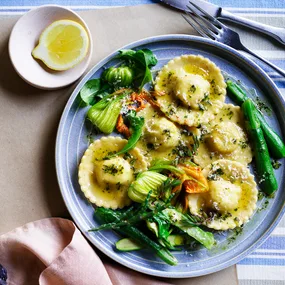For many Chinese people, especially those from Guangzhou province, sweet and sour pork is a memorable part of their childhood. A dish that speaks of nostalgia and comfort, it’s universally loved by my Chinese friends and by me. So I was shocked when some of my Aussie friends said it was stodgy and unpalatable.
Surprised by this, I decided to visit my suburban Chinese takeaway. I was stunned. One whiff of this gloopy mess called sweet and sour pork was enough to make me recoil in horror. Looking more like a radioactive cherry-red sauce, it bore no resemblance to the ones I grew up with. What’s more, the sauce was way too sweet. As for the sour component, it was so vinegary I could barely eat it. The gristly cubes of pork were equally bad. I have no idea how this Westernised version came about, but it’s totally different to the ones in China and South East Asia.
Sweet and sour pork is a classic Cantonese dish. Its fame is such that the Chinese call it gu lao rou, meaning pork with a long history. Perhaps this has something to do with its origin, which some Chinese writers have linked to the famed sweet and sour spare ribs from Jiangsu province. Called tang cu pai gu, it’s a favourite with the folks of Jiangsu for its distinctive vinegary, sweet flavour. From here, it travelled to Guangzhou (Canton) and morphed into the dish we know today.
I don’t remember the exact moment when I made my first gu lao rou (gu lou yok in Cantonese). But I know I learnt to make it when my parents had their Cantonese restaurant in Malaysia. At that time, we had a great Chinese chef, who told me this dish is one of the benchmarks of Cantonese cooking. He said a good sweet and sour sauce should be light and the pieces of pork should be hot, crisp and flavoursome, and served immediately to maintain the crispness.
To achieve the fine balance of flavours, he used only fresh pineapple and capsicum for colour along with chillies for lingering heat. Since then I have used it as a yardstick whenever I make this dish, or whenever I dine at a Chinese restaurant.
Some of the best sweet and sour pork I’ve eaten was in Hong Kong, served in both the most basic dai pai dong – food stalls – and starred restaurants. According to chef Tsang Chiu Lit at Ming Court restaurant, the secret to a great sauce is to use only rice vinegar, for its low acidity. I can only concur on this point. Once you’ve made this version, I promise you’ll never go back to a mediocre Chinese restaurant for sweet and sour pork again.
Making sweet and sour pork isn’t difficult, but, as with any good cooking, it requires planning and timing.
Step 1: Slice pork into bite-sized pieces
The first thing is to select your cut of pork. For me, pork neck is best because it has a good distribution of lean meat and fat. Slice it into bite-sized pieces.

Step 1: Slice pork into bite-sized pieces
(Photo: Ben Hansen)Step 2: Marinate the pork
Next, marinate the pork in good Shaoxing wine, soy sauce and five-spice powder to lock in the flavours (essentials in your arsenal of Asian pantry staples) . Short of making your own five-spice – most commercial ones are poor quality-wise – if you come across Deer Brand five-spice, it will make your dish sing. A beaten egg thrown in at this stage makes coating the meat with flour much easier later.

Step 2: Marinate the pork
(Photo: Ben Hansen)Step 3: Meanwhile, make the sweet and sour sauce

Step 3: Meanwhile, make the sweet and sour sauce
(Photo: Ben Hansen)Step 4: Prepare your vegetables
There are no hard and fast rules as to which greens to use, but it’s important to include garlic, onion and spring onion for the scent. Most Cantonese cooks incorporate capsicum, pineapple and sometimes tomatoes into the mix.

Step 4: Prepare your vegetables
(Photo: Ben Hansen)Step 5: Deep-fry the pork
When you’re ready to cook, have oil in a wok ready to deep-fry the pork, and the rice and potato flour mixture ready to coat the marinated pork before frying. Deep-fry the pork in batches until golden brown, then remove the cubes with a slotted spoon and drain them on paper towels. (In better Chinese restaurants, the pork is deep-fried twice to maintain its crispness).

Step 5: Deep-fry the pork
(Photo: Ben Hansen)Steps 6 and 7: Stir-fry the vegetables
Transfer the oil to a heatproof container, wipe the wok with paper towels and return it to the heat. Add a tablespoon of oil and, when it’s hot, add the onion and garlic. Stir-fry until just aromatic, then add the pineapple and capsicum.

Steps 6 and 7: Stir-fry the vegetables
(Photo: Ben Hansen)Steps 8 and 9: Add the sweet and sour sauce, and potato flour dissolved in water
Toss for another 20 seconds, then add the sauce, spring onion and tomato, followed by the slurry of potato flour and water.

Steps 8 and 9: Add the sweet and sour sauce, and potato flour dissolved in water
(Photo: Ben Hansen)Step 10: Stir in the pork
As soon as the sauce begins to bubble, stir in the pork, transfer the mixture to a large bowl and serve it with steamed or fried rice.

Step 10: Stir in the pork
(Photo: Ben Hansen)And serve…
Once you’ve made this version, I promise you’ll never go back to a mediocre Chinese restaurant for sweet and sour pork again.
Sweet and sour pork recipe
Serves 4 | Preparation time: 20 mins | Cooking time: 15 minutes









